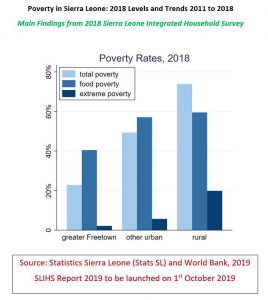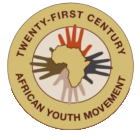Poverty in Sierra Leone: 2018 Levels and Trends 2011 to 2018[yikes-mailchimp form=”1″ title=”1″ description=”1″ submit=”Subscribe To Receive Emails”]
Main Findings from 2018 Sierra Leone Integrated Household Survey
Poverty remains high in Sierra Leone with the official poverty rate at 56.8% in 2018. Calculations from the 2018 SLIHS place the food poverty line (the amount needed to buy a sufficient amount of food following the local diet) at Le 2,125,000 annually per adult equivalent, and the total poverty line (accounting for both food and non-food expenditure) at Le 3,921,000 per adult equivalent. This results in an extreme poverty rate of 12.9%, a food poverty rate of 54.5% and an overall poverty rate of 56.8%.
 Poverty is concentrated in the rural areas in Sierra Leone. Poverty rates in rural areas are more than twice as high as in urban areas, 73.9% compared to 34.8%. Separating out Greater Freetown (all urban areas in Western Area), we find that Freetown has a significantly lower poverty rate (22.8%) than other urban areas (49.3%). Extreme poverty rates show an even greater disparity: the rate is 19.9% in rural areas and 3.8% in urban areas. Food poverty rates show less variation and the rate for rural areas is quite close to the rate for other urban areas, showing that although those in rural areas are much poorer overall, they are no worse than urban dwellers (outside of Freetown) in terms of having sufficient food. Poverty depth and severity (which consider not just whether households are poor, but how poor they are and inequality among the poor) show stark disparities between urban and rural areas.
Poverty is concentrated in the rural areas in Sierra Leone. Poverty rates in rural areas are more than twice as high as in urban areas, 73.9% compared to 34.8%. Separating out Greater Freetown (all urban areas in Western Area), we find that Freetown has a significantly lower poverty rate (22.8%) than other urban areas (49.3%). Extreme poverty rates show an even greater disparity: the rate is 19.9% in rural areas and 3.8% in urban areas. Food poverty rates show less variation and the rate for rural areas is quite close to the rate for other urban areas, showing that although those in rural areas are much poorer overall, they are no worse than urban dwellers (outside of Freetown) in terms of having sufficient food. Poverty depth and severity (which consider not just whether households are poor, but how poor they are and inequality among the poor) show stark disparities between urban and rural areas.
The North is the province with the highest rate of poverty, districts Tonkolili, Pujehun, and Falaba have the highest rates by district. Poverty rates are 64.1% in the East, 76.5% in the North, 62.3% in the North-West, 67.7% in the South and 23.3% in the West. Poverty rates vary widely within provinces, however, and the three poorest districts (Pujehun, Tonkolili, and Falaba) span the far south, center and far north-east of the country. The least poor districts are Western Area Urban and Rural, Kambia and Bonthe.
National poverty has decreased modestly since 2011 driven by decreases in urban areas. The new poverty rate of 56.8% is not directly comparable to the official rate of 52.9% in 2011, due to differences in methodology and setting a new (higher) poverty line for 2018. Adjusting for these changes, we do find that poverty has decreased by 5.6 percentage points. Poverty in rural areas has remained flat (increased by a statistically insignificant amount) while poverty in urban areas has decreased significantly (by 6.2 percentage points), concentrated in urban areas outside of Freetown. All the regions saw decreases in poverty, but only that in the West is statistically significant. Extreme poverty has not changed overall since 2011 but increased in rural areas (5.3 percentage points) and the East (5.9 percentage points). Food poverty has increased significantly (8.4 percentage points) with particularly large increases in rural areas, the East and the North.
Full SLIHS 2018 report to be launched on 1st October 2019
Osman Sankoh1, Alejandro De la Fuente2 and Elizabeth Forster3 on behalf of the SLIHS 2018 Writing Group:
- Statistics Sierra Leone (Stats SL), Freetown, Sierra Leone
- World Bank, Washington DC, USA
- World Bank, Freetown, Sierra Leon
